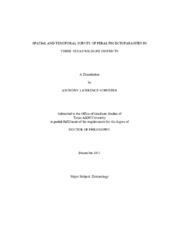| dc.description.abstract | Feral pigs, European wild boars and their crosses are ubiquitous and found in all ecological zones from Florida to California. These introduced animals are recorded in 39 US states and four Canadian provinces. Texas currently has an estimated population of 1-4 million pigs with the potential to exceed 4 million based on suitable habitat estimates. Feral pigs can modify local flora and fauna and cause significant physical damage with their rooting activities. They can also reintroduce parasites and pathogens to previously parasite and pathogen free herds of domestic cattle, horses, sheep, and goats. The two overarching objectives of this research were to determine what role feral pigs have in the maintenance and possible distribution of fleas, lice, and ticks common to the three wildlife districts; and if they serve as bridging hosts for the same (or other) arthropods and their natural hosts. The supporting objectives were to establish host records of fleas, lice, and ticks parasitizing feral pigs; determine species assemblies within each of the three wildlife districts; and to compare species assemblies among the wildlife districts.
Feral pigs (564) were taken from June 2008 to March 2011 using box, corral, and panel traps in three wildlife districts. Two hundred fifty six fleas, Pulex porcinus (Jordan and Rothschild), were collected from all gender and age classes of feral pigs at the South Texas Plains wildlife district. No fleas were collected at either the Hill Country or Post Oak Savannah wildlife districts. This is the first report of these fleas on feral pigs. Lice and ticks were collected from all gender and age classes of feral pigs from all sample sites. Only hog lice, Haematopinus suis, were collected at all three sample sites. Seven species of ticks were collected from the three sites: Amblyomma americanum, A. cajennense, A. maculatum, Dermacentor albipictus, D. halli, D. variabilis, and Ixodes scapularis. Amblyomma cajennense was collected only at the South Texas Plains sample site; A. americanum and I. scapularis were collected only at the Hill Country and Post Oak sample sites. This study reports that feral pigs are serving as hosts for one species of flea, one species of lice and seven species of ticks common to Texas. | en |


